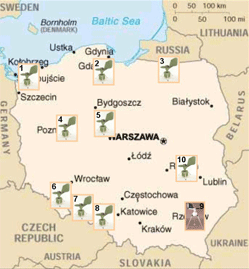|
The spatial scope of forecasting of each trap is defined on
the basis of climatic regions of Poland (Wiszniewski and Chelchowski, 1987).
Where there are two traps in the same region or where they are situated on the
borderline of two or more regions, then as far as climate is concerned we make
corrections for the specific location of each trap.
Monitoring of pseudothecia maturation
Fruiting bodies are divided into pycnidia (anamorph stage, producing pycnidiospores)
and pseudothecia (teleomorph, producing ascospores). Pycnidiospores are unable
to infect plants grown in different fields whilst ascospores produced in pseudothecia
are released after rainfall and may infect the rapeseed plants over a wide area.
Pseudothecia are divided into five classes of maturation A-E and among them
the most infectious is class D with 8 fully mature ascospores in each ascus.
Out of 44 locations, 10 of the pseudothecial maturation sampling sites correspond
to ascospore trap locations and the remaining pseudothecial maturation sampling
sites are located in other parts of the climatic regions or in the borderline
areas between these regions.
Monitoring encompasses 45 locations in all provinces of Poland :
- Lower Silesia: Tarnow, Zloty Potok
- Kujavia and Pomerania: Glebokie, Naklo
- Lublin region: Bezek, Lesniowice, Pulawy
- Gorzow region: Malyszyn, Szprotawa, Świebodzin
- Lodz region: Koscierzyn, Maslowice, Annoslaw, Walewice
- Cracow region: Wieliczka
- Mazovia: Radom, Radzikow, Siedlce
- Carpathian Foothills: Krasne
- Suwalki region: Lyski, Suwalki
- Pomerania: Radostowo
- Upper Silesia: Sosnowiec, Sosnicowice, Zawada, Zory
- Swietokrzyskie region: Modliszewice
- Warmia; Mazuria: Biala Piska, Drogosze, Warkały
- Great Poland: Baborowko, Bielawy, Cerekwica, Jerka, Pawlowice, Dolaszewo,
Poznan, Strzalkowo, Szczodrzykowo
- West Pomerania: Szczecin, Rarwino
The results concernig pseudothecia maturity in Swietokrzyskie and Upper Silesia
regions are shown as points on the map in the recent news column. Rapeseed cultivation
is at risk of stem canker disease if class D pseudothecia are present. Private
people, who gave us access to their fields and gardens, experimental stations
of Research Center for Cultivar Testing, Plant Breeding Station in Strzelce
(branch Malyszyn), experimental stations of IPG PAS, Research Center for Agricultural
and Forest Enironment, Institute of Soil Science and Plant Cultivation, ecological
station of Adam Mickiewicz University as well as commercial agricultural centers
in Mazovia, Swietorzyskie and Lodz region take part in monitoring pseudothecia
maturity.
|






